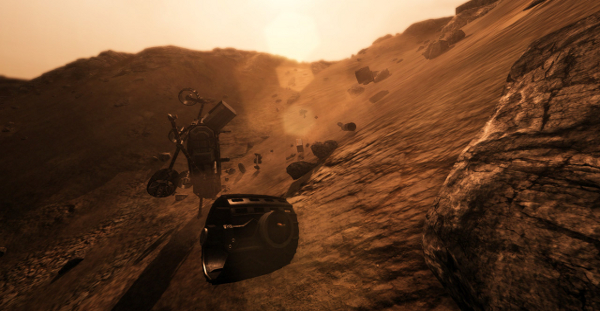Take On The Martian In Take On Mars
Matt Damon simulator.
At first glance, Take On Mars [official site] seems like the closest thing we have to a tie-in game for The Martian. You could almost call it Mark Watney Simulator 2015, especially now that manned missions are in the game and let you do things like build Martian bases, grow crops, and drive rugged rovers over the desolate Martian surface. Hell, there's even a mission where you literally have nothing to do inside your base except grow potatoes. It's just a fecal-matter montage away from being the first act of The Martian.
But I am no Mark Watney. And the Red Planet is a much harsher, weirder place in Bohemia Interactive's vision than in Ridley Scott's. Mark Watney is nearly killed by flying debris during a Martian sandstorm. In Take On Mars, no storm is as terrifying and unpredictable as the physics engine.
My Martian adventures start in the Victoria Crater, where my astronaut has been deposited along with a heavy rover, a landing craft, and a the bare skeleton of a base. It's a bit of a fixer-upper: there's a greenhouse with some survival gear, and two 3D printers that will spit-out anything from a rover to a bedroom set to an airlock.
Here's the catch: you have to assemble everything, and most of the pieces don't fit together, even when it looks like they should. Everything has a set of anchoring points that have to match up with another set of anchoring points. So even though it might look like a doorway and a tunnel should go together, they probably won't.
I feel like I'm trying to build a ship in a bottle using only my tongue. My astronaut spends hours dragging bits of space-station around the base, slowly wiggling and wobbling the pieces around until the "ASSEMBLE" option flickers on screen and I can tie them together.
It's dangerous work: the faster you move around, the higher your heart rate gets and the more oxygen you use up. I also end up falling over a lot, for reasons I don't fully understand. Sometimes my astronaut is carrying a piece of paneling up a set of stairs and it seems like the edge catches on a doorframe, and the next thing I know I've been thrown to the ground. After a long hesitation, my astronaut slowly clambers back to his feet like a man defeated. I know how he feels.
All the little stumbles and trips, along with some very-ill advised jumping on to taller platforms, have taken a toll. In no time at all, I've somehow damaged my suit. The only space suit on Mars, apparently. My 3D printers cannot make another one.
Just moving around has become more hazardous. My base is strewn with cast-off pieces of equipment. Useless doors and doorways cover the ground like paving stones, because they would not fit the airlock-entrance I'd built. Somehow, a piece of the foundation ended up trapped inside an airlock passageway, clipping straight through two walls and forcing me to disassemble the entire thing. So far, building a Martin base is a lot of like trying to assemble a living room set out of a bunch of random IKEA parts.
Sometimes, the things I'm carrying around seem to get spring-loaded as they slam into other pieces of the environment. I watch in chagrin as airlocks, airlock doors, structural supports, and even entire stairways go flying off into the Martian night, necessitating another hike back to the 3D printers. I consider hopping in a rover to retrieve a stairway that was supposed to lead up into my base but decide to leave it as a monument to mankind's hubris.
On one trip back to the rover, where I can refill my space suit's oxygen supply, I stumble over some unrecognizable piece of space-base and watch as my suit takes another hit. I'm not Mark Watney. I'm Sideshow Bob in the field of rakes.
Apparently I'm still nursing a concussion a few minutes later when I don my space suit again and open the rover's airlock to get back to work… without ever putting on my helmet. I slam the door shut before I can suffocate, then try again.
After a few more hours of work, I have… a large empty room, and an airlock with a passageway leading into thin-air. My gear is damaged, and I'm starting to suspect that building a functional base will take another 10 hours or so of painstaking agony. Since my oxygen supply is getting a little low anyway, I head back to the cozy confines of my landing craft, where I at least have a bed and the doors all work.
I try another scenario. This one seems more Mark Watney-like. I just have to hold-down a completed colony and harvest potatoes. That should be something I can handle.
At first, everything seems normal. I tend to my hydroponic garden, changing out the water-tank to make sure my potatoes are getting the moisture they need. Apparently I'm also supposed to go outside and gather methane from the collectors, which is when I notice that my space suit is sitting in the airlock, surrounded by hard vacuum. I am literally trapped in two rooms, like a hamster in the world's worst habitrail.
Then things get weirder. In the second room, there is another airlock door. Like the first one, it's showing that there's no atmosphere on the other side. But when I even walk too closely to this door, which is thrown into shadow by the setting Martin sun, my astronaut starts gasping for breath and dying of asphyxiation. It even looks like a sinister gateway to hell, now that I think of it.
Trapped in two featureless rooms with nothing to do except literally watch my potatoes grow, I decide that I'd rather risk death than sit in this Martian prison. I throw the airlock door open, ignoring my astronaut's desperate gasping, and trudge over to the space suit. I manage to get it on just before my character passes out. After a minute of rest, he's ready to get to work.
One of Take On Mars' latest features is electricity. You can run cabling from wall sockets and solar power generators to the machinery you use around your base. So even though all the equipment around this colony is powered-down, I have a 3D printer and can create both solar panels and cable spools.
What's powering the 3D printer, you ask? In this case, I believe it is incomplete feature implementation.
Anyway, I print myself a solar panel and, after much trial-and-error, eventually get it to stand upright on the uneven Martian surface. Then I print a cable spool and drag over to the solar panel and some nearby equipment.
If you were worried that the Take On Mars physics engine wouldn't give cables unique properties and mass of their own, worry not: the power cables are 10 meter-long segments of pure chaos. Just unspooling one cable, I manage to whip it around and send my solar panel bouncing into the crater below. So I make another, and get ready to power-up my first machinery.
The solar panels all have clear sockets for the male end of the power cables, so I drag the plug over to the solar panel and waggle at the socket until I get the option to "connect power". Ah, romance!
But when I take the other end of the socket over to same soil extractors I want to power-up, I'm pushing rope. The extractors have plugs, and the other end of the cable has a socket, so it should be no problem to get these things working. But the magic just won't happen.
I even use my helmet camera to zoom and try to guide the cable socket onto the plug. Instead, I just end up ineffectually slapping the cable against the junction box. Oh God, not this again.
As I stand there with my power cable in my hand and consider the life choices that have led me to this moment, I'm not sure Take On Mars is ready to be taken-on. Like my base itself, it's a collection of disparate pieces that still require a lot of construction and troubleshooting.
I'm ready to be abandoned on Mars and left to fend for myself. There is an eerie beauty to this game, even if it is a beauty that is more foreboding and faintly sinister than what you see The Martian. I felt a curious feeling of safety and loneliness each time I retreated to one of my spaceships and sealed myself inside, gazing at the rust-colored landscape from behind the safety of a window.
But my attempts to actually do things like build and survive on a Martian base left me feeling less like Mark Watney and more like Basil Fawlty. It's more slapstick than science.











